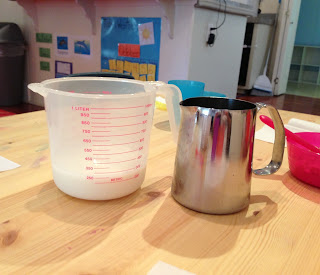Thursday, December 13, 2012
Painting with Bows
Wrapping Presents in Preschool
Tuesday, December 11, 2012
Christmas Countdown Calendar
Friday, November 16, 2012
Pine Cone Turkeys
Thursday, November 15, 2012
What Will the Ants Eat?
Friday, November 9, 2012
Building Bird Nests
This week our class has been interested in birds. On Wednesday we watched a video of a bird building a nest and talked about what birds' nests are made of. We talked about how birds collect twigs, leaves, and other things to use for their nests. When we went outside, we pretended we were all birds and collected lots of small sticks. Then I gave the children paper and glue...
Here is one of the finished products:
Today, when all the glue was finally dry, we made these little Pom-Pom birds to sit in the nests.
It may not be apparent at first glance that they are birds but, if you look closely, you can see that the blue one has two pink eyes and a purple beak.
Saturday, November 3, 2012
Mixing Colors with Eye Droppers
Our class has been working a lot on small muscle skills over the past two weeks. One of my favorite small muscle activities is using eye droppers. Last week we used them to mix different colored paints. I started by squeezing about a tablespoon of washable tempura paint into a bowl and then filling the bowl with water to make a very watery paint solution. I did this with four different colors.
Next, I gave each of the children an eye dropper and a clear cup filled with water (I used clear cups so that they could really see the colors mixing). At first the children didn't understand that they had to sqeeze and then let go before the eye droppers would pick up the paint. But after a little practice, they were able to get some paint into them and squeeze it into the water.
Once they got the hang of it, everyone really enjoyed seeing the different colors and shades they could make their water.
They liked it so much that they refilled their cups with clear water and mixed new colors for about an hour.
Besides helping children to develop the small muscles in their hands and fingers, this activity is a good science project because it allows them to experiment with mixing. I loved that some of the children would try to remember the colors they had mixed previously so that they could reproduce the results.
Tuesday, October 23, 2012
The Rainbow Fish Printable Game
Here's the link to download my fish templates, which you can color and cut out: http://www.aspenleafpreschool.com/wp-content/uploads/2012/10/Fish-templates.pdf
Tuesday, October 16, 2012
Family Style Dining in Preschool: A How-To Guide
Then one cup and one spoon or fork on each plate. Later, when they have gotten used to the process, they are able to set the dishes out without the napkins marking the spots.

Once everyone is at the table, we sing (about our hands):
Open, shut them,
Open, shut them,
Give a little clap, clap, clap.
Open, shut them,
Open, shut them,
Put them in your lap, lap, lap.
This helps to get everyone's attention, calm the children down, and let them know that the meal is about to start. Before passing the bowls around, I show the children how many of each food they should take. I do this by serving myself and narrating what I'm doing. For example I would take two scoops of cereal and say, "This is the cereal. I can take two scoops. One, two. Now I'm going to pass it."
If we are having toast or bagels, I will set out a bowl of jelly. The children take a scoop of jelly with the serving spoon and then spread it with their knives (whenever we use knives we talk about how to be careful with them. Even though they are only plastic, it is important for children to know how to be safe with them).
Once they get used to pouring, I fill the small pitcher about half way and show them how to stop pouring before the cup over flows.The first time a child pours without spilling is a big deal and I always make sure to compliment him or her.
At the end of the meal, each child cleans up his or her own place. We have a nice big sink in the classroom for all the dirty dishes, while napkins and uneaten food are placed in the trash. Every day we talk about what goes in the trash and what goes in the sink. If you're not mindful, you'll end up losing all of your dishes to the garbage!
Make sure to always sit down with the class and demonstrate the kinds of behaviors you expect from them. In order for this to work, the teachers have to lead by example. So make sure to set a place for yourself! Once everyone gets used to family style dining, you will find that it is much easier than making plates for the children and serving them. It is also much more pleasant to sit at the table with the children and have a conversation than it is to stand over them refilling their plates and cups.
To read about the benefits of using family style dining, check out my earlier post Family Style Dining in Preschool: Why it's Important.


















































